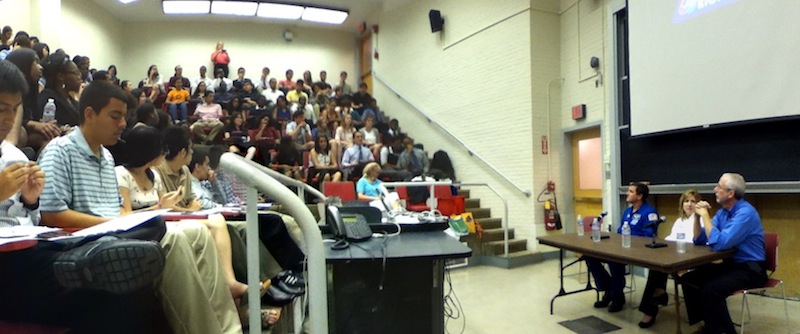
Theresa Johnson, MITES ’01, is combining aeronautics and astronautics with entrepreneurship as she works to inspire future scientists and engineers along the way.
When she arrived on MIT’s campus for the first time in June 2001, Theresa Johnson didn’t know anything about engineering. Her high PSAT scores and academic drive had helped secure her a spot in that year’s Minority Introduction to Engineering and Science (MITES) program, but her primary reason for attending was to enjoy a summer outside of her hometown of St. Louis. Over a decade later, Theresa is a Ph.D. candidate at Stanford University, where she is combining aeronautics and astronautics with entrepreneurship as she works to inspire future scientists and engineers along the way.
Raised in a series of college towns – first Urbana-Champaign, Illinois, then Austin, Texas, and finally St. Louis, Missouri – Theresa experienced deep socio-economic divides. Theresa’s parents did not have college degrees and were looked down upon as “townies” in communities dominated by large universities.
Despite their social status, Theresa’s parents worked hard to thrive and shield her from potentially toxic atmospheres. Theresa recalls her mother taking on a number of projects, including launching her own dog walking service, to provide for her. “I hadn’t heard the word ‘entrepreneur’ until my summer in MITES,” Theresa says. “But I saw it in my parents.”
Through grade school, Theresa’s teachers identified her as an academic star. Theresa remembers taking a liking to math, in particular, as early as second grade. By middle school, her academic talent began to work against her. “In eighth grade, I had a teacher, Mr. Brownfield, who saw that I was getting bored,” Theresa says. “He pushed me to improve my work ethic.”
That increased work ethic would put her into a position to enroll in MITES in summer 2003 after her junior year of high school. During MITES, Theresa faced a number of challenges. Academically, she says, “it was the most rigorous experience I ever had at that point in my life.” She had to put more work into her MITES physics class than she did for any of her high school classes.
Outside of the classroom, Theresa faced challenges as well. It was the first time she had been surrounded by people from such different socio-economic backgrounds. “Some people could just go out to the movies or out for dinner whenever they wanted,” she says. “It was difficult for those like me always budgeting. And we didn’t have the vocabulary to talk about socio-economic disparity.”
Ultimately, her experiences academically and socially gave her new perspective. “It matured me. It grounded me,” Theresa says. Most of all, she appreciated the sense of community that MITES provided, and she still keeps in touch with many of her MITES peers and teaching assistants, especially those now on the west coast.
During her senior year of high school, Theresa gained acceptance to her top three schools – Stanford, MIT and Harvard. Ultimately, she chose to attend Stanford “for its interdisciplinary engineering education, entrepreneurial vibrancy, opportunity for exploration, and cultural groundedness,” she says. Entering Stanford with the insights she gained during MITES, Theresa breezed through her first year in a Science, Technology and Society program. “MITES prepared me for that workload,” she says. “I probably had a 3.8 or 3.9 GPA in my first year of Stanford undergrad, and I certainly have to credit MITES for preparing me for that level of rigor.”

Theresa points out a calibration chamber used for an experiment at the Max Planck Institute in Germany. Theresa managed a team of research scientists and other graduate students for the experiment as part of her work toward a Ph.D. from Stanford.
While excelling academically, Theresa explored the cultural vibrancy that Stanford had to offer by joining Delta Sigma Theta, a historically black public service sorority, studying as an exchange student at Spelman, a top historically black college for women, and studying and working abroad in Japan, Ghana, Ethiopia, Switzerland, Greenland, and Germany, among other places.
Today, Theresa is a fifth year Ph.D. student in aerospace engineering at Stanford. She is working on a number of projects with the Stanford Technology Ventures Program, which develops inventions and ideas in the lab and spins them out into startups. She hopes that one of her projects will become a launching pad for her career out of graduate school, but she is also interested in joining one of the many existing startups in Silicon Valley that are focusing on aerospace or “the internet of things,” which, with its connection to satellites, drones, and high-altitude balloons, she finds deeply interesting.
Ultimately, Theresa says, she has learned and grown with the help of many role models along the way, and she wants to be a role model, herself, to let others know that anything is possible. “Flying cars are possible. Getting us to Mars is possible. It’s all going to happen,” she says. “It just takes the will, intellect, and spunk of a few to light that fire.”
—Nick Holden
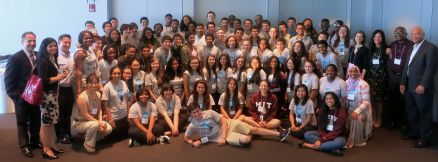


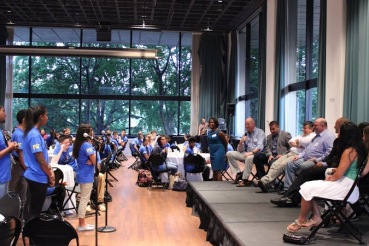
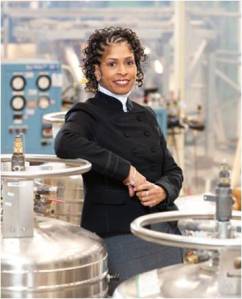

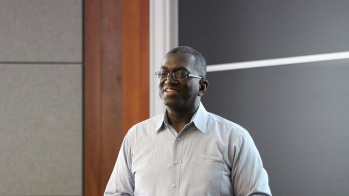

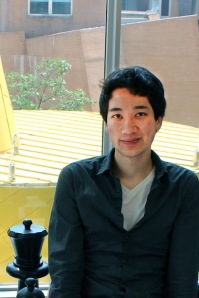
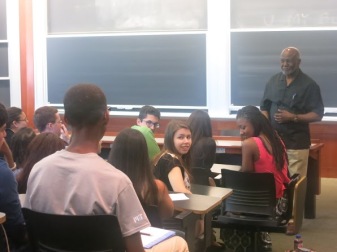
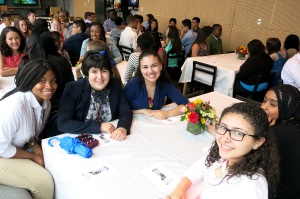


![Architecture program students Zoe Toledo of Logan, UT and Esrat Bristee of Boston, MA put finishing touches on their model phone booth, called “Modern Cubism.” In their project description, they wrote that “in essence [the] structure is providing people the opportunity to stop and take a moment to view the world in a different way.”](https://mitoeop.files.wordpress.com/2013/10/49a5861-copy.jpg?w=450&resize=450%2C450&h=450#038;h=450&crop=1)











